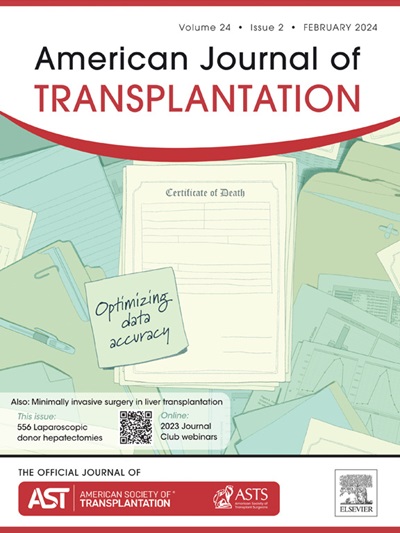OPTN/SRTR 2023 Annual Data Report: Deceased Organ Donation
IF 8.9
2区 医学
Q1 SURGERY
引用次数: 0
Abstract
The Annual Data Report is created using data from the Scientific Registry of Transplant Recipients (SRTR) to calculate variables such as organs recovered per donor, organs transplanted per donor, and organs recovered for transplant but not transplanted (ie, nonuse). SRTR uses data collected by the Organ Procurement and Transplantation Network. In 2023, there were 16,335 deceased donors, a 9.6% increase from 14,904 in 2022 and continuing the trend of increasing donors over the past decade. Donor characteristics have changed compared with 2013, with more donors with drug intoxication and cardiovascular mechanisms of death. In contrast, gunshot wound, blunt injury, and stroke have decreased as mechanisms of death in 2023 compared with 2013. The number of organs transplanted increased to 40,588 in 2023 (from 37,316 in 2022), including 10,818 left kidneys, 10,659 right kidneys, 372 en bloc kidneys, 917 pancreata, 9,910 livers, 95 intestines, 4,596 hearts, and 3,016 lungs. Compared with 2022, transplants of all organs increased. In 2023, 4,038 left kidneys, 4,220 right kidneys, 160 en block kidneys, 279 pancreata, 1,056 livers, 4 intestines, 68 hearts, and 260 lungs were not used. This nonuse of organs represents an opportunity to increase the number of transplants.
求助全文
约1分钟内获得全文
求助全文
来源期刊
CiteScore
18.70
自引率
4.50%
发文量
346
审稿时长
26 days
期刊介绍:
The American Journal of Transplantation is a leading journal in the field of transplantation. It serves as a forum for debate and reassessment, an agent of change, and a major platform for promoting understanding, improving results, and advancing science. Published monthly, it provides an essential resource for researchers and clinicians worldwide.
The journal publishes original articles, case reports, invited reviews, letters to the editor, critical reviews, news features, consensus documents, and guidelines over 12 issues a year. It covers all major subject areas in transplantation, including thoracic (heart, lung), abdominal (kidney, liver, pancreas, islets), tissue and stem cell transplantation, organ and tissue donation and preservation, tissue injury, repair, inflammation, and aging, histocompatibility, drugs and pharmacology, graft survival, and prevention of graft dysfunction and failure. It also explores ethical and social issues in the field.

 求助内容:
求助内容: 应助结果提醒方式:
应助结果提醒方式:


